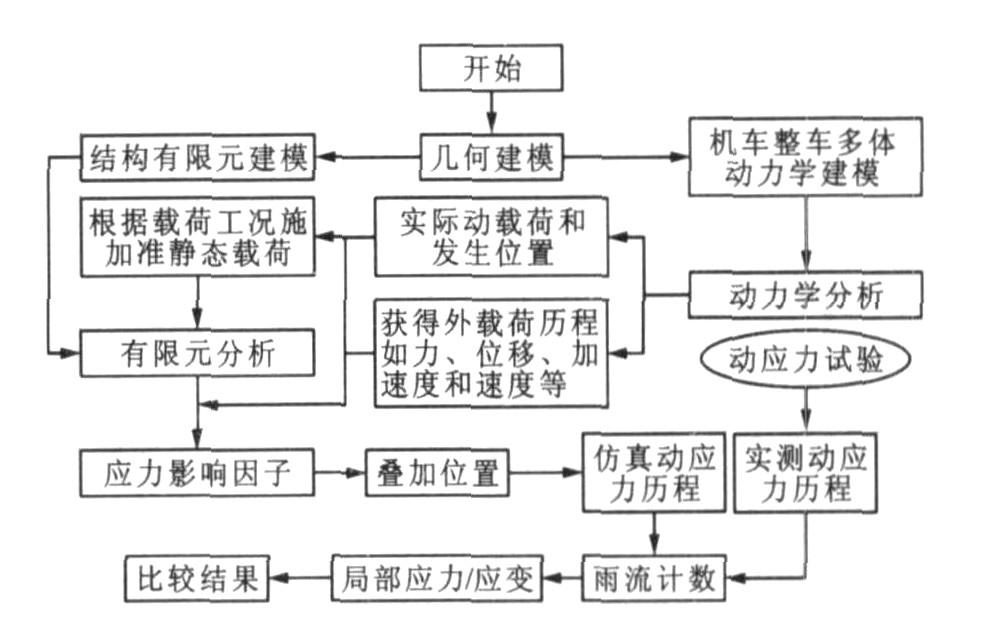Dynamic stress calculation method of locomotive and vehicle carbody structures
Article Text (Baidu Translation)
-
摘要: 为了提高机车车辆的疲劳寿命, 优化其结构设计, 提出了基于多系统仿真模型和有限元方法的动应力混合计算方法, 计算了机车车辆车体结构的动应力。建立以车体为核心的机车多体系统仿真模型, 并进行动力学分析, 获得关键位置的载荷时间历程。通过有限元准静态应力法, 计算了车体结构的准静态应力影响因子。通过载荷时间历程和对应单位载荷作用下的应力影响因子的相互相乘叠加求和计算, 获得车体结构在随机动载作用下的应力历程, 对实际线路车体结构动应力测试结果和刚性车体与柔性车体的仿真结果进行了对比。对比结果表明: 其误差分别是2.462%和7.258%, 说明此计算方法计算精度高。Abstract: In order to improve the fatigue lives of locomotive and vehicle and optimize their carbody structures, a synthetical computation method of dynamic stress was proposed based on multi-body system (MBS) simulation model and finite element method, and the dynamic stresses of locomotive and vehicle carbody structures were calculated.Taking carbody as core, MBS simulation model of locomotive was established, and its simulation analysis was performed to obtain the load time histories of crucial positions.Finite element method (FEM) and quasi-static stress analysis method were used to calculate stress influence coefficients (SIC).Carbody dynamic stress history was produced by multiplying each stochastic load-time history by the SIC resulted from corresponding unit load, and the dynamic stress test result of carbody structure was compared with the simulation result of rigid and flexible carbodies.Comparison result shows that their errors are 2.462% and 7.258% respectively, which indicates that the computational precision of the method is high.
-
Key words:
- vehicle engineering /
- carbody structure /
- dynamic stress analysis /
- MBS /
- FEM
-
表 1 实测和仿真应力
Table 1. Test and simulation stresses
名称 平均值/MPa 最小值/MPa 最大值/MPa 应力范围/MPa 刚体节点91040 -0.120 66 -27.959 28 35.114 44 63.073 73 柔体节点91040 -0.114 27 -29.384 21 40.300 18 69.684 39 测点5-3 -0.383 47 -29.420 92 35.205 40 64.626 32 -
[1] Stefan D, Hel muth N, Delf S. Fatigue life prediction of arail way bogie under dynamic loads through si mulation[J]. Vehicle System Dynamics, 1998, 29 (3): 385-402. [2] Ki m HS, Yi m HJ, Ki m C B. Computational durability predic-tion of body structure in prototype vehicles[J]. International Journal of Automotive Technology, 2002, 3 (4): 129-135. [3] James A R. Methodology for evaluating vehicle fatigue life anddurability[D]. Knoxville: the University of Tennessee, 2003. [4] Kuti I. Si mulation of vehicle motions onthe basis of the finiteelement method[J]. Vehicle System Dynamics, 2001, 36 (6): 445-469. doi: 10.1076/vesd.36.6.445.3545 [5] Sung I S, Choon P, Ki m K H. Fatigue strength evaluation ofthe aluminumcarbody of urban transit unit bylarge scale dy-namic load test[J]. JSME International Journal, 2005, 48 (1): 27-34. doi: 10.1299/jsmea.48.27 [6] 缪炳荣. 基于多体动力学和有限元法的车体结构疲劳仿真研究[D]. 成都: 西南交通大学, 2006. [7] 蔡成标, 翟婉明, 赵铁军, 等. 列车通过路桥过渡段时的动力作用研究[J]. 交通运输工程学报, 2001, 1 (1): 17-19. http://transport.chd.edu.cn/article/id/200101004Cai Cheng-biao, Zhai Wan-ming, Zhao Tie-jun, et al. Re-search on dynamic interaction of train and track on roadbedbridge transition section[J]. Journal of Traffic and Transpor-tation Engineering, 2001, 1 (1): 17-19. (in Chinese) http://transport.chd.edu.cn/article/id/200101004 [8] 王开云, 刘建新, 翟婉明, 等. 铁路行车安全性及舒适性仿真[J]. 交通运输工程学报, 2006, 6 (3): 9-12. http://transport.chd.edu.cn/article/id/200603003Wang Kai-yun, Liu Jian-xin, Zhai Wan-ming, et al. Run-ning safety and comfortability si mulation of rail way[J]. Jour-nal of Traffic and Transportation Engineering, 2006, 6 (3): 9-12. (in Chinese) http://transport.chd.edu.cn/article/id/200603003 -





 下载:
下载:












